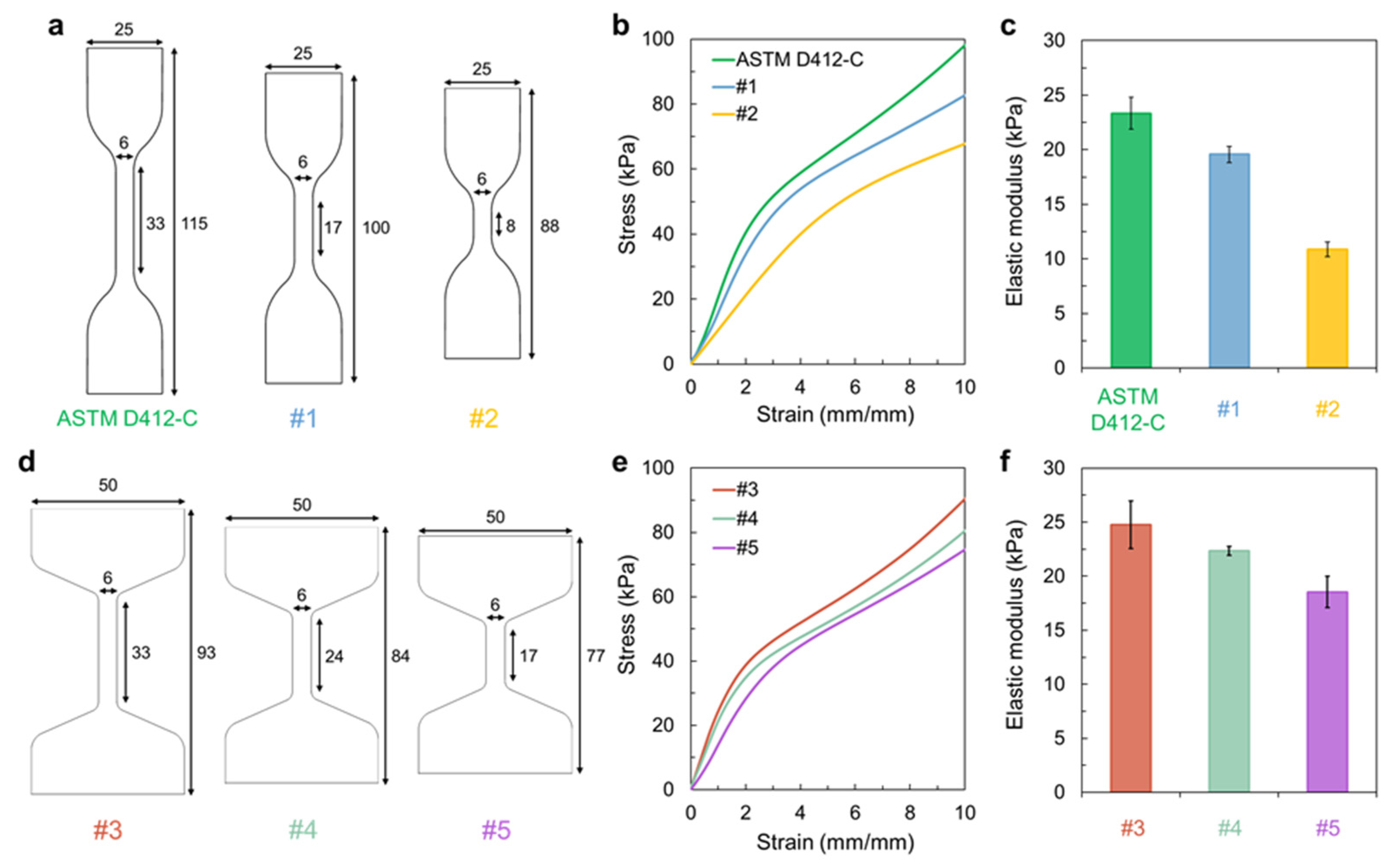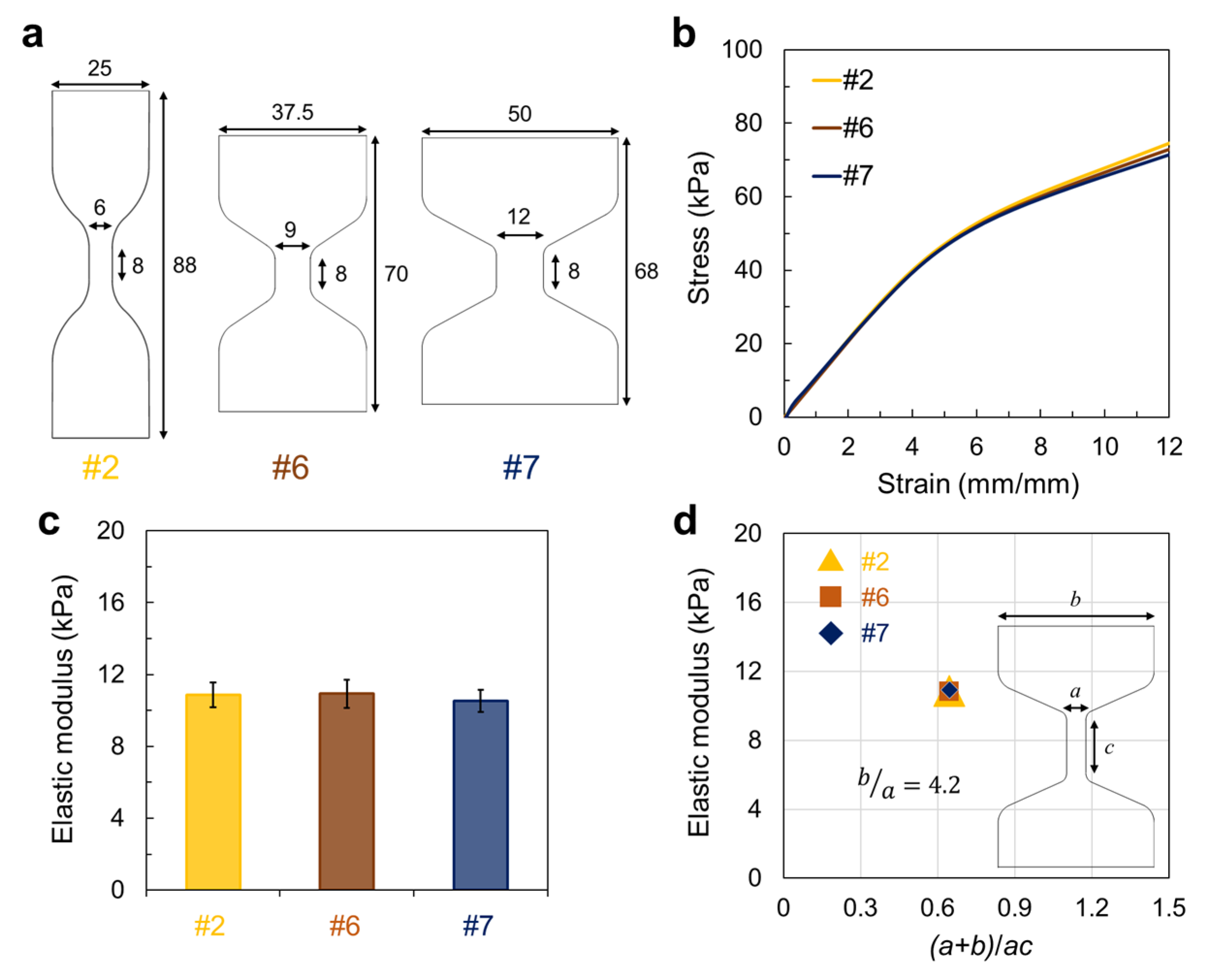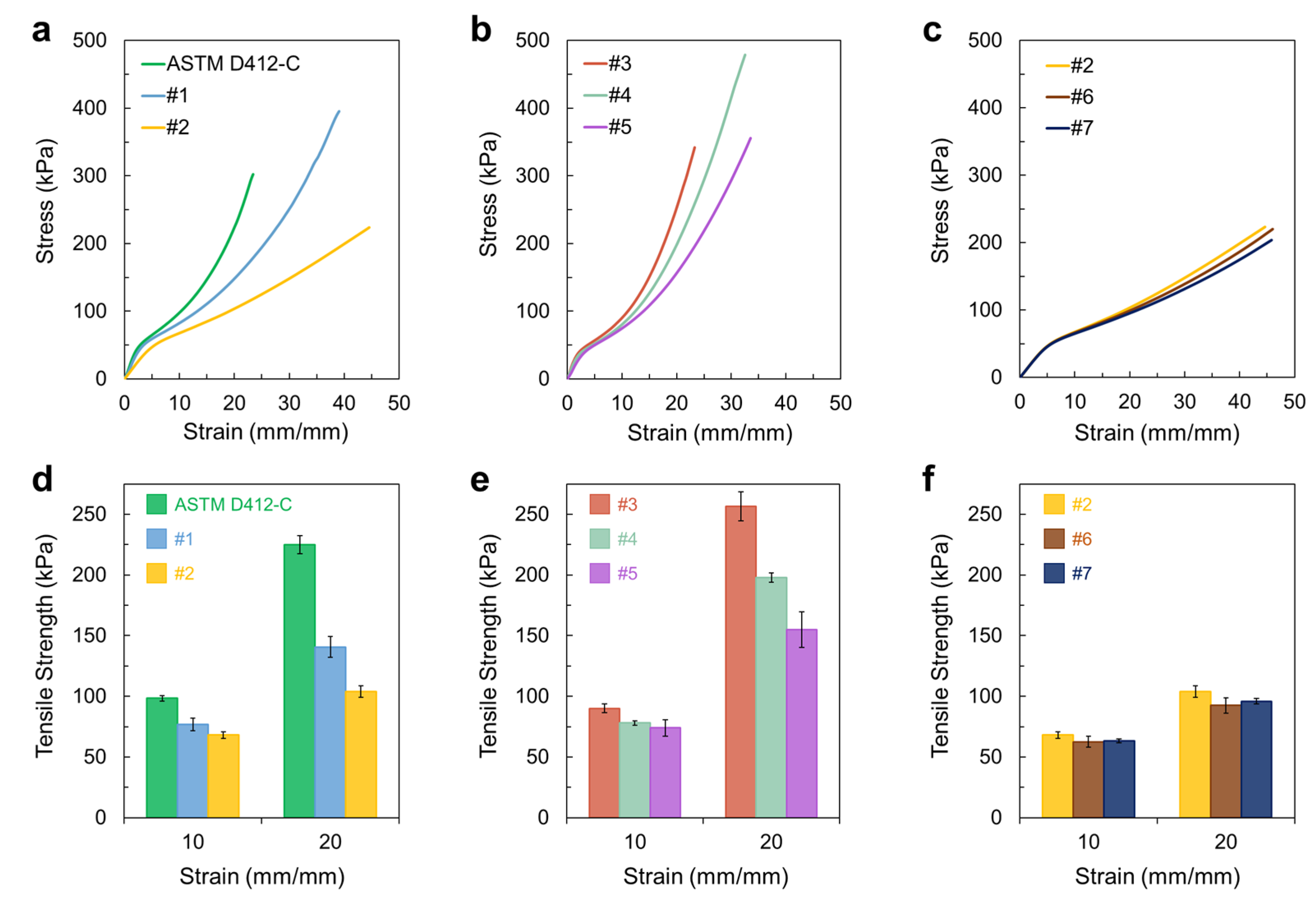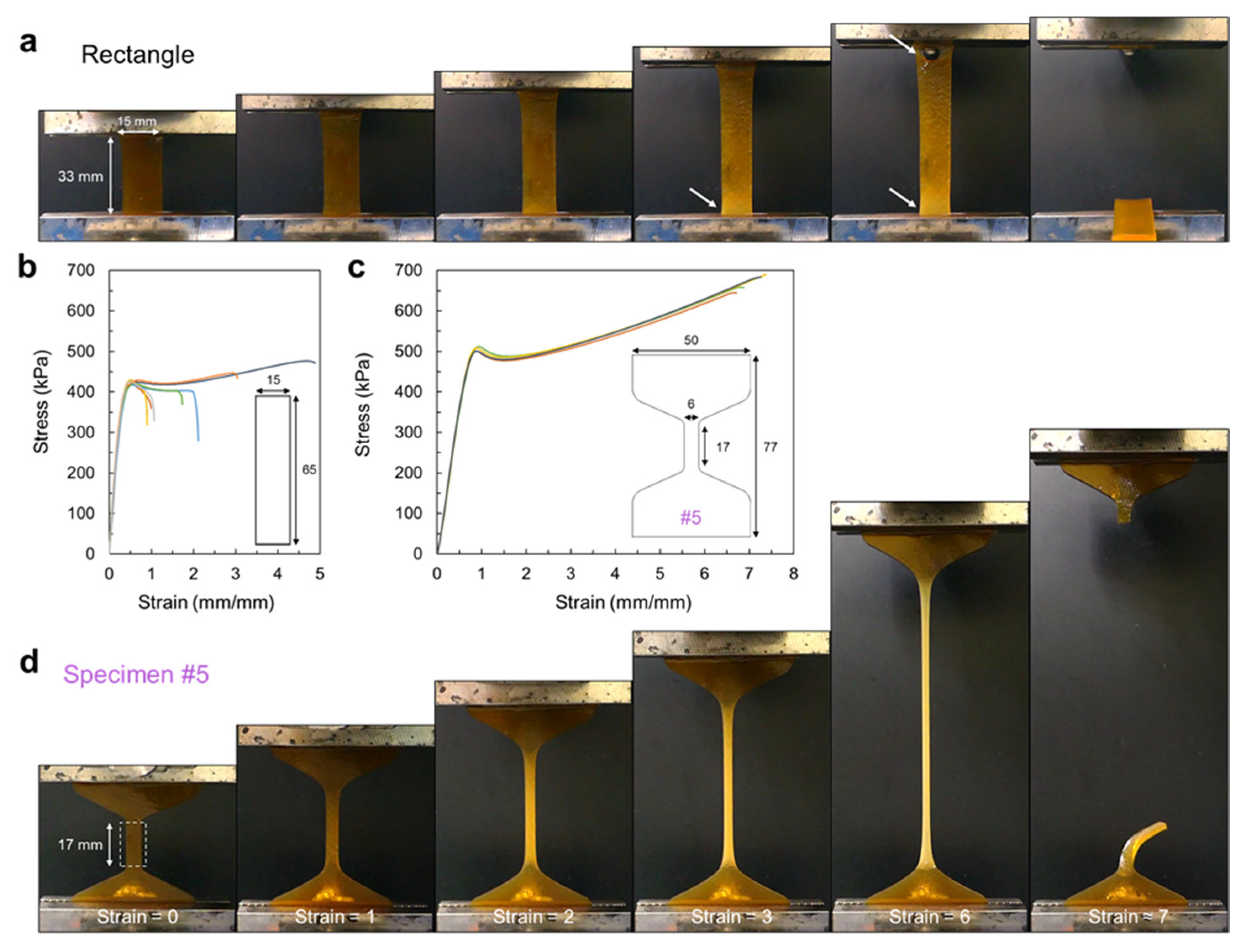Specimen Geometry Effect on Experimental Tensile Mechanical Properties of Tough Hydrogels
Abstract
1. Introduction
2. Experimental Section
2.1. Materials
2.2. Preparation of Alginate/Polyacrylamide (Alg/PAM) Double-Network (DN) Tough Hydrogels
2.3. Preparation of Hydrogel Specimens
2.4. Mechanical Test
2.5. Statistical Analysis
3. Results and Discussion
3.1. Difference between Rectangle and ASTM and JIS Standards

3.2. Difference Caused by Gauge Length/Width of the Reduced Section of the Dumbbell-Shaped Specimen
3.3. Load Concentration in the Reduced Section Rather than the Clamping Region
4. Conclusions and Outlook
Author Contributions
Funding
Data Availability Statement
Conflicts of Interest
References
- Gong, J.P.; Katsuyama, Y.; Kurokawa, T.; Osada, Y. Double-Network Hydrogels with Extremely High Mechanical Strength. Adv. Mater. 2003, 15, 1155–1158. [Google Scholar] [CrossRef]
- Sun, J.-Y.; Zhao, X.; Illeperuma, W.R.K.; Chaudhuri, O.; Oh, K.H.; Mooney, D.J.; Vlassak, J.J.; Suo, Z. Highly Stretchable and Tough Hydrogels. Nature 2012, 489, 133–136. [Google Scholar] [CrossRef] [PubMed]
- Sun, T.L.; Kurokawa, T.; Kuroda, S.; Ihsan, A.B.; Akasaki, T.; Sato, K.; Haque, M.A.; Nakajima, T.; Gong, J.P. Physical Hydrogels Composed of Polyampholytes Demonstrate High Toughness and Viscoelasticity. Nat. Mater. 2013, 12, 932–937. [Google Scholar] [CrossRef] [PubMed]
- Li, X.; Cui, K.; Sun, T.L.; Meng, L.; Yu, C.; Li, L.; Creton, C.; Kurokawa, T.; Gong, J.P. Mesoscale Bicontinuous Networks in Self-Healing Hydrogels Delay Fatigue Fracture. Proc. Natl. Acad. Sci. USA 2020, 117, 7606–7612. [Google Scholar] [CrossRef]
- Mredha, M.T.I.; Guo, Y.Z.; Nonoyama, T.; Nakajima, T.; Kurokawa, T.; Gong, J.P. A Facile Method to Fabricate Anisotropic Hydrogels with Perfectly Aligned Hierarchical Fibrous Structures. Adv. Mater. 2018, 30, 1704937. [Google Scholar] [CrossRef]
- Choi, S.; Choi, Y.; Kim, J. Anisotropic Hybrid Hydrogels with Superior Mechanical Properties Reminiscent of Tendons or Ligaments. Adv. Funct. Mater. 2019, 29, 1904342. [Google Scholar] [CrossRef]
- Axpe, E.; Orive, G.; Franze, K.; Appel, E.A. Towards Brain-Tissue-Like Biomaterials. Nat. Commun. 2020, 11, 3423. [Google Scholar] [CrossRef]
- Lin, W.; Kluzek, M.; Iuster, N.; Shimoni, E.; Kampf, N.; Goldberg, R.; Klein, J. Cartilage-Inspired, Lipid-Based Boundary-Lubricated Hydrogels. Science 2020, 370, 335–338. [Google Scholar] [CrossRef]
- Ji, D.; Kim, J. Recent Strategies for Strengthening and Stiffening Tough Hydrogels. Adv. NanoBiomed. Res. 2021, 1, 2100026. [Google Scholar] [CrossRef]
- Gong, J.P. Materials both Tough and Soft. Science 2014, 344, 161–162. [Google Scholar] [CrossRef]
- Chen, Q.; Zhu, L.; Zhao, C.; Wang, Q.; Zheng, J. A Robust, One-Pot Synthesis of Highly Mechanical and Recoverable Double Network Hydrogels Using Thermoreversible Sol-Gel Polysaccharide. Adv. Mater. 2013, 25, 4171–4176. [Google Scholar] [CrossRef] [PubMed]
- Chen, Q.; Wei, D.; Chen, H.; Zhu, L.; Jiao, C.; Liu, G.; Huang, L.; Yang, J.; Wang, L.; Zheng, J. Simultaneous Enhancement of Stiffness and Toughness in Hybrid Double-Network Hydrogels via the First, Physically Linked Network. Macromolecules 2015, 48, 8003–8010. [Google Scholar] [CrossRef]
- Yang, Y.; Wang, X.; Yang, F.; Shen, H.; Wu, D. A Universal Soaking Strategy to Convert Composite Hydrogels into Extremely Tough and Rapidly Recoverable Double-Network Hydrogels. Adv. Mater. 2016, 28, 7178–7184. [Google Scholar] [CrossRef] [PubMed]
- Dutta, A.; Maity, S.; Das, R.K. A Highly Stretchable, Tough, Self-Healing, and Thermoprocessable Polyacrylamide–Chitosan Supramolecular Hydrogel. Macromol. Mater. Eng. 2018, 303, 1800322. [Google Scholar] [CrossRef]
- Yang, Y.; Wang, X.; Yang, F.; Wang, L.; Wu, D. Highly Elastic and Ultratough Hybrid Ionic–Covalent Hydrogels with Tunable Structures and Mechanics. Adv. Mater. 2018, 30, 1707071. [Google Scholar] [CrossRef]
- Wu, J.; Pan, Z.; Zhao, Z.Y.; Wang, M.H.; Dong, L.; Gao, H.L.; Liu, C.Y.; Zhou, P.; Chen, L.; Shi, C.J.; et al. Anti-Swelling, Robust, and Adhesive Extracellular Matrix-Mimicking Hydrogel Used as Intraoral Dressing. Adv. Mater. 2022, 34, 2200115. [Google Scholar] [CrossRef]
- Dai, X.; Wang, J.; Teng, F.; Shao, Z.; Huang, X. Zr(IV)-Crosslinked Polyacrylamide/Polyanionic Cellulose Composite Hydrogels with High Strength and Unique Acid Resistance. J. Polym. Sci. Part B Polym. Phys. 2019, 57, 981–991. [Google Scholar] [CrossRef]
- Li, J.; Suo, Z.; Vlassak, J.J. Stiff, Strong, and Tough Hydrogels with Good Chemical Stability. J. Mater. Chem. B 2014, 2, 6708–6713. [Google Scholar] [CrossRef]
- Yang, C.H.; Wang, M.X.; Haider, H.; Yang, J.H.; Sun, J.-Y.; Chen, Y.M.; Zhou, J.; Suo, Z. Strengthening Alginate/Polyacrylamide Hydrogels Using Various Multivalent Cations. ACS Appl. Mater. Interfaces 2013, 5, 10418–10422. [Google Scholar] [CrossRef]
- Choi, S.; Kim, J. Designed Fabrication of Super-stiff, Anisotropic Hybrid Hydrogels via Linear Remodeling of Polymer Networks and Subsequent Crosslinking. J. Mater. Chem. B 2015, 3, 1479–1483. [Google Scholar] [CrossRef]
- Choi, S.; Choi, Y.j.; Jang, M.-S.; Lee, J.H.; Jeong, J.H.; Kim, J. Supertough Hybrid Hydrogels Consisting of a Polymer Double-Network and Mesoporous Silica Microrods for Mechanically Stimulated On-Demand Drug Delivery. Adv. Funct. Mater. 2017, 27, 1703826. [Google Scholar] [CrossRef]
- Liang, M.; He, C.; Dai, J.; Ren, P.; Fu, Y.; Wang, F.; Ge, X.; Zhang, T.; Lu, Z. A High-Strength Double Network Polydopamine Nanocomposite Hydrogel for Adhesion under Seawater. J. Mater. Chem. B 2020, 8, 8232–8241. [Google Scholar] [CrossRef]
- Xu, C.; Zhang, X.; Liu, S.; Zhao, X.; Geng, C.; Wang, L.; Xia, Y. Selected Phase Separation Renders High Strength and Toughness to Polyacrylamide/Alginate Hydrogels with Large-Scale Cross-Linking Zones. ACS Appl. Mater. Interfaces 2021, 13, 25383–25391. [Google Scholar] [CrossRef] [PubMed]
- Park, N.; Kim, J. Anisotropic Hydrogels with a Multiscale Hierarchical Structure Exhibiting High Strength and Toughness for Mimicking Tendons. ACS Appl. Mater. Interfaces 2022, 14, 4479–4489. [Google Scholar] [CrossRef] [PubMed]
- Ji, D.; Nguyen, T.L.; Kim, J. Bioinspired Structural Composite Hydrogels with a Combination of High Strength, Stiffness, and Toughness. Adv. Funct. Mater. 2021, 31, 2101095. [Google Scholar] [CrossRef]
- ASTM D412-16; Standard Test Methods for Vulcanized Rubber and Thermoplastic Elastomers—Tension. ASTM International: West Conshohocken, PA, USA, 2016.
- JIS K 6251; Rubber, vulcanized or thermoplastic-Determination of tensile stress-strain properties. Japanese Standards Association (JSA): Tokyo, Japan, 2017.





| Hydrogels | Specimen Shapes | Specimen Size a Width × Length × Thickness [mm3] | Test Speed [mm min−1] | Strain Rate b [min−1] | Ref. |
|---|---|---|---|---|---|
| Alg/PAM | Rectangle | 75 × 5 × 3 | 10 | 2.0 | [2] |
| Alg/PAM | Rectangle | 10 × N.M. × N.M. | 60 | N.M. | [6] |
| Alg/PAM | Dumbbell | 2 × 12 × 2 | 100 | 8.3 | [19] |
| Alg/PAM | Rectangle | 5 × N.M. × 3 | 60 | N.M. | [20] |
| Alg/PAM | Rectangle | 5 × 30 × 3 | 60 | N.M. | [21] |
| Alg/PAM | Rectangle | 45 × 40 × 2 | 5 | 0.5 | [22] |
| Alg/PAM | Dumbbell | 2 × 35 × 1.8 | 100 | 2.9 | [23] |
| Alg/PAM | Dumbbell | 5 × 10 × 5 | 60 | 6 | [24] |
| Agar/PAM | Dumbbell | 4 × 30 × 1 | 50 | 1.7 | [11] |
| Agar/PAM | Dumbbell | 4 × 25 × 1 | 100 | 4.0 | [12] |
| Chitosan/PAM | Rectangle | 5 × N.M. × 2 | 50 | N.M. | [13] |
| Chitosan/PAM | Rectangle | 5 × N.M. × 1.5 | 10 | N.M. | [14] |
| Chitosan/PAM | Rectangle | 5 × 35 × 1.5 | 10 | N.M. | [15] |
| Chitosan/PAM | Rectangle | N.M. × 10 × N.M. | N.M. | 0.1 | [16] |
| Cellulose/PAM | Dumbbell | 4 × 16 × 4 | 40 | 2.5 | [17] |
| PVA/PAM | Rectangle | 75 × N.M. × 3 | N.M. | 2 | [18] |
Disclaimer/Publisher’s Note: The statements, opinions and data contained in all publications are solely those of the individual author(s) and contributor(s) and not of MDPI and/or the editor(s). MDPI and/or the editor(s) disclaim responsibility for any injury to people or property resulting from any ideas, methods, instructions or products referred to in the content. |
© 2023 by the authors. Licensee MDPI, Basel, Switzerland. This article is an open access article distributed under the terms and conditions of the Creative Commons Attribution (CC BY) license (https://creativecommons.org/licenses/by/4.0/).
Share and Cite
Ji, D.; Im, P.; Shin, S.; Kim, J. Specimen Geometry Effect on Experimental Tensile Mechanical Properties of Tough Hydrogels. Materials 2023, 16, 785. https://doi.org/10.3390/ma16020785
Ji D, Im P, Shin S, Kim J. Specimen Geometry Effect on Experimental Tensile Mechanical Properties of Tough Hydrogels. Materials. 2023; 16(2):785. https://doi.org/10.3390/ma16020785
Chicago/Turabian StyleJi, Donghwan, Pilseon Im, Sunmi Shin, and Jaeyun Kim. 2023. "Specimen Geometry Effect on Experimental Tensile Mechanical Properties of Tough Hydrogels" Materials 16, no. 2: 785. https://doi.org/10.3390/ma16020785
APA StyleJi, D., Im, P., Shin, S., & Kim, J. (2023). Specimen Geometry Effect on Experimental Tensile Mechanical Properties of Tough Hydrogels. Materials, 16(2), 785. https://doi.org/10.3390/ma16020785








